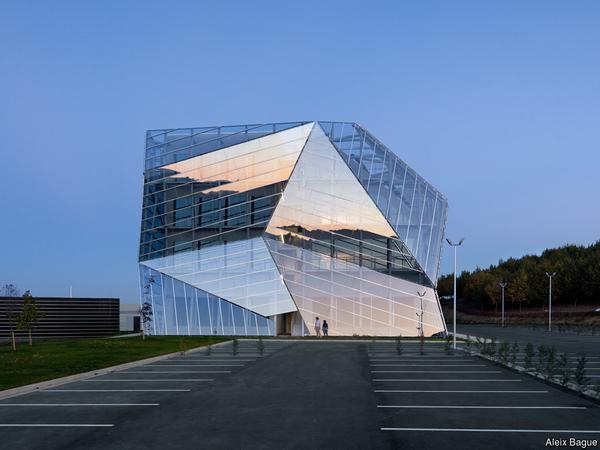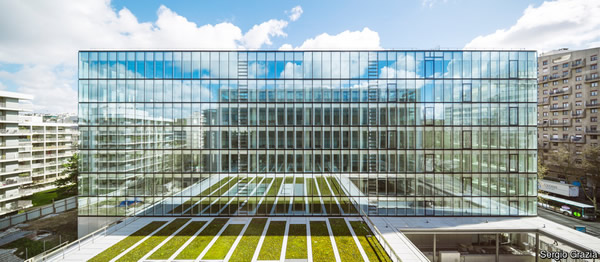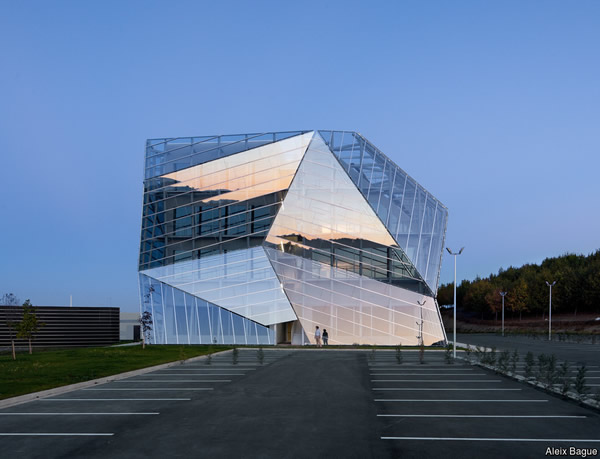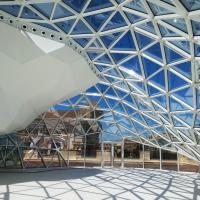
Date: 14 June 2019
When designing a double skin façade, it is important to choose the right combination of glass to optimise the benefits in terms of energy management, dynamic selectivity, thermal insulation, and enhanced comfort, while minimising potential issues such as condensation, says Ralf Greiner, Product Application Manager for Guardian Glass in Europe.
A double skin façade application is a traditional façade that has a second cover on the outside that is normally made of glass. The two facades, often called “skins”, are separated by an empty space (air gap), the width of which can vary from a few centimetres to several metres. If mechanical shading systems are installed in the air gap, the outer skin also provides them protection against wind loads and dirt.
A double skin façade can be either mechanically or naturally ventilated, depending on the type of ventilation system used in the air gap. These are known as active and passive (interactive) ventilated facades.

Active systems have an outer skin of airtight insulation glass in front of the ventilated inter space. Air exchange is artificially induced and takes place inside the building via heat exchangers. In winter, this has the advantage that energy required for heating can be saved via heat recovery. Active systems tend to use the more traditional glass types for the external insulating glass skin.
Passive ventilated façades are the more common type in Europe, particularly on commercial buildings. Here, the air exchange takes place between the inter space and the environment. A natural convection is created via defined openings, which are normally located above and below the outer glass. Suspended glass walls in front of a conventional construction are also possible, as are punctuated facades, as well as box-type windows or compound windows.
The benefits of a double skin façade
Due to increasingly higher standards on protection against heat gain and therefore low solar energy transmission, double skin facades that combine energy efficient glazing with mechanical shading devices are becoming increasingly popular.
Although they’ve been installed in buildings over the last 20 years or so, glass technology has progressed considerably during this time, which has helped increase their use. Today, innovative glass products and coatings are available for double skin facades that help provide numerous benefits – but only if the right combination of glass is selected for the external and internal skins.
The number of glazing combinations and possibilities available today are staggering. This provides architects with a full palette of glass performance and aesthetics options to consider; they can choose the most suitable glazing in terms of glass performance, thickness, dimensions, thermal and mechanical resistance (durability), solar protection, colour, etc.
Chosen correctly, the glass can provide advantages in terms of improved energy management, sound insulation, thermal insulation, as well as the possibility of enjoying fresh air from the cavity through opened windows and therefore enhanced comfort for building occupants. Furthermore, additional shading systems can be placed between the outer and inner glazing, providing dynamic selectivity (i.e. the ratio between maximum daylighting and maximum solar protection).

Solar radiation reflecting coatings in the outer shell can significantly reduce the energy transmission when blinds are fully retracted compared with a conventional solution without coatings. Users can operate the mechanical shading smarter (either open or in intermediate states) and enjoy unobstructed views for longer without having to fear overheating. It’s all about finding the right balance for the building; glazing solutions can help you achieve that near-perfect balance.
Coated solar control glass
Advanced coated solar control glass, for example, can actively optimise the daylighting factor (DF), as well as the building’s thermal regulation. The glass can help to make the building more energy efficient by reducing the need for air conditioning, heating and artificial lighting, which all contribute to a more comfortable working or living environment for building occupants. As a result, these glazing solutions can also be instrumental in helping to achieve environmental certifications such as LEED, BREEAM, HQE, DGNB, etc.

In passive ventilated facades, the aim is normally to reflect a part of the short-wave solar energy directly from the outer glass so that the heat build-up in the inner space is reduced and, in turn, the thermal load. The use of coatings on the glass is significantly reinforced when combined with additional sun and anti-glare protection in the inner space. Excellent g-values are also achieved when the blinds are operated in a fully retracted or intermediate state. The dynamic selectivity that can be achieved in this way renders the ventilated system particularly attractive.
Another advantage of using coatings in the outer glazing is the possibility to play with various light reflection grades. This allows the architect to design very transparent and apparently “light” constructions or using higher reflections for creating a uniform appearance and hiding a patchwork of individually adjusted shading devices.
The challenge of durable coatings
While the inner glazing of a passive system is conventional double or triple insulating glass, for the outer single glazing a laminated safety glass (often consisting of heat strengthened glass) is typically used. Its residual load capacity ensures maximum safety in case of breakage.
The challenge when using high performance coated glass is that the coating must be both durable and suitable for using monolithically or laminated facing the interlayer. Most coatings on the market are very sensitive to humidity and external climatic elements, which means they often need to be hermetically sealed, which obviously limits the flexibility.
The combination of high durable solar control coatings for reflecting a share of the solar radiation with special energy absorbing PVB interlayers do further improve the energy efficiency. In particular, the spectral selectivity (daylight to solar energy ratio) can be significantly enhanced.

Potential issues
While architects may be familiar with the advantages of double skin facades, there are some potential disadvantages that require careful consideration. Again, it is important to select the right combination of glass that minimises these potential issues, while optimising the benefits.
A double skin façade with the wrong glass combination may also decrease the amount of natural light entering a building, while increasing the temperature in the air gap (which can lead to shorter operating life of electric motors, heat exchanger systems, etc.) and creating condensation on the external skin.
Condensation
In passive ventilated facades – depending on the position of the building and adverse climatic conditions – condensation can occur on the inner side of the outer glass pane. Of particular concern are the morning hours in spring and autumn, when potential condensation can significantly disrupt the clear views from inside the building. Again, this doesn’t have to be an issue, as glass solutions are now available to prevent this natural phenomenon from occurring.
Anti-fog coatings for glass are specially designed, extra-durable coatings applied onto the outer glass pane, which significantly reduce the probability of condensation. Tests under real building conditions have shown that these anti-fog coating solutions provide slightly higher surface temperatures compared to an uncoated outer surface. This temperature difference significantly reduces the appearance of condensation.
While the uncoated glazing in comparison tests shows condensation over many hours, under the same conditions, the coated glass remains clear and free of water droplets throughout. One word of caution: it is essential to consider the use of anti-fog coated glass at the project planning stage, as the application of such coatings after installation is not possible.
Other potential issues with double skin facades include higher investment and operating expenses. An additional skin around a building places a higher demand (load/weight) on the ground area. This must be taken into account at the project planning stage. There may also be higher sound transmission between neighbouring rooms in the building if windows are left open.
A guiding hand
For advice and guidance on choosing the right combination of glass for your double skin façade, we have a team of experts who can help. The Guardian SunGuard® range of coated solar control glass offers a variety of products with attractive aesthetics and technical properties to help optimise the performance of double skin façades and minimise the issues sometimes associated with them.
To ask for assistance, go to https://www.guardian-possibilities.com/en/contact-us
About the expert - Ralf Greiner
 After graduating from the TU Bergakademie Freiberg, Germany, in 1993 studying Material Science - Glass and Ceramics, Ralf Greiner joined Guardian Glass in 1996.
After graduating from the TU Bergakademie Freiberg, Germany, in 1993 studying Material Science - Glass and Ceramics, Ralf Greiner joined Guardian Glass in 1996.
He held several positions in the technical advisory center and marketing departments. The extensive experience he has acquired during these years led him to the position of Product Application Manager for Guardian Glass in Europe.
 600450
600450






















Add new comment